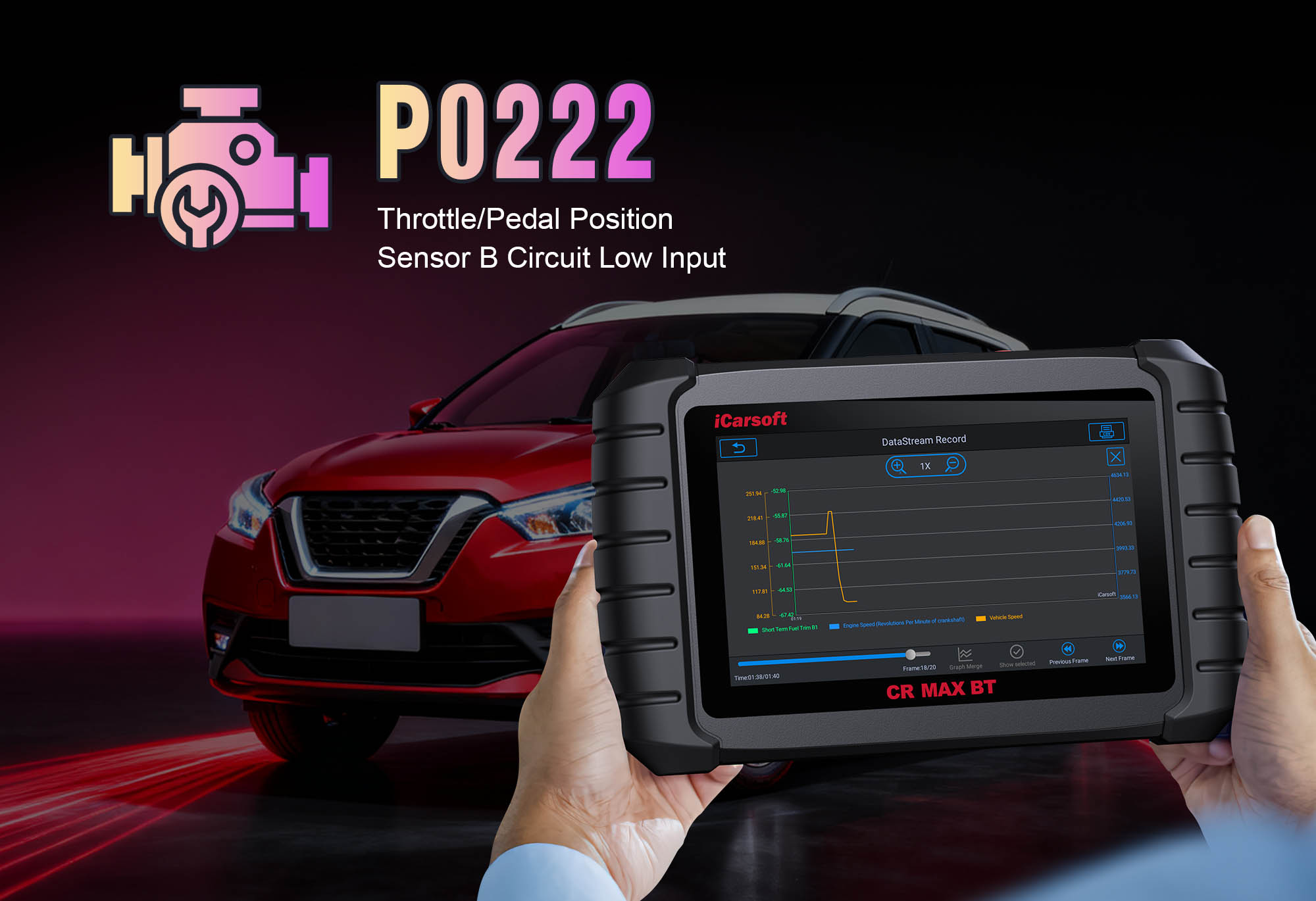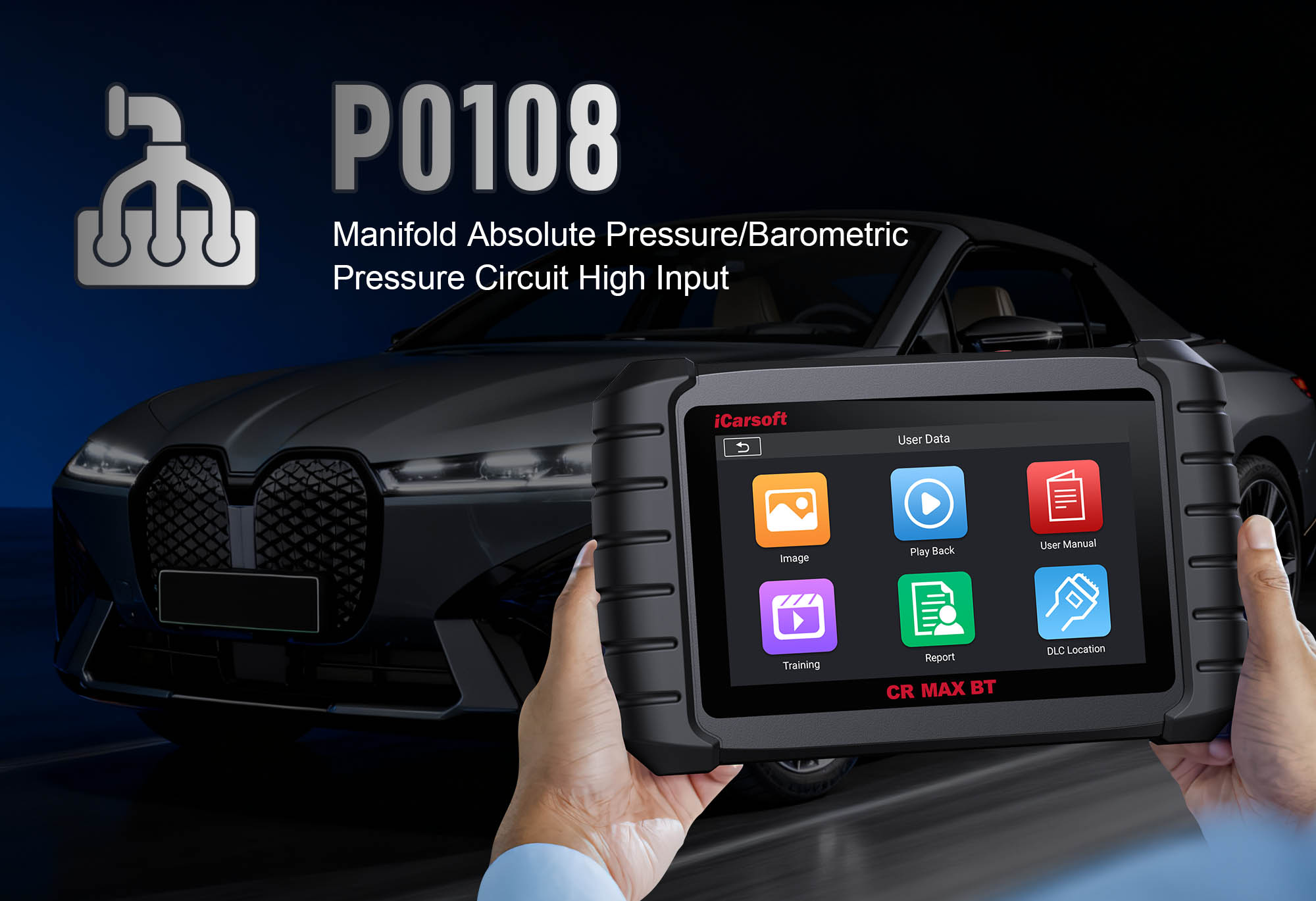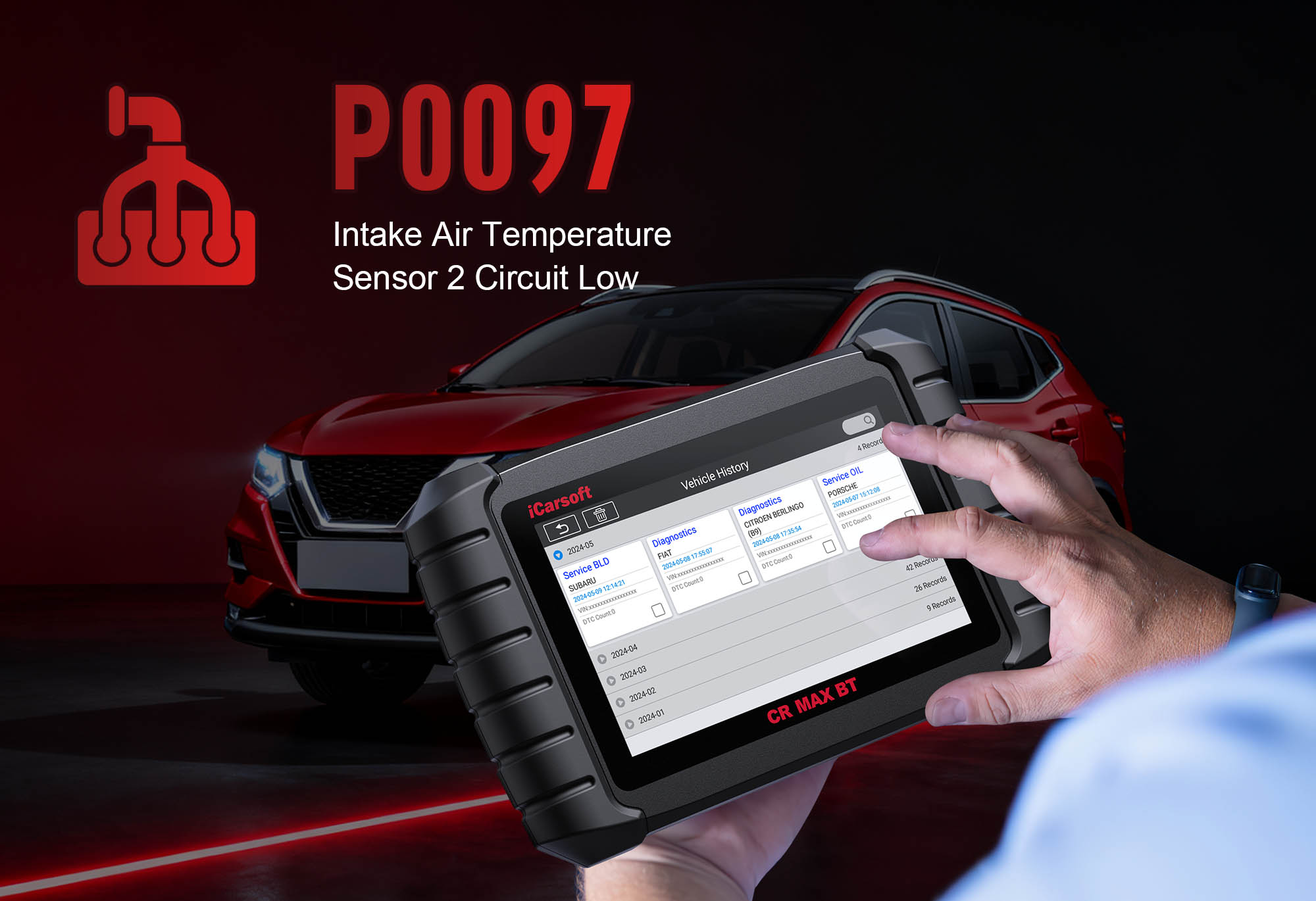Diagnose & Clear P0222 with iCarsoft CR MAX BT: Fix Throttle Position Sensor A Circuit Low Voltage
Diagnose & Clear P0222 with iCarsoft CR MAX BT
If your vehicle struggles with unresponsive acceleration, stalls at low speeds, or gets stuck in "limp mode," a diagnostic scan will likely return P0222. This OBD-II code stands for "Throttle Position Sensor (TPS) A Circuit Low Voltage"—a critical fault targeting the primary TPS, often integrated with the electronic throttle body.
The Engine Control Module (ECM) relies on TPS signals to adjust fuel injection and ignition timing. When voltage drops below the manufacturer’s threshold (typically <0.2V), the ECM loses accurate throttle data, leading to erratic performance and safety risks. Basic scanners can’t isolate faults, but the iCarsoft CR MAX BT with specialized TPS diagnostics solves this. Let’s break down how to resolve P0222 step by step.
Understanding P0222: Symptoms & Causes
The primary TPS (Sensor A) converts the throttle valve’s mechanical movement to electrical signals: ~0.5V at idle (closed throttle) and ~4.5V at wide-open throttle (WOT). P0222 triggers when voltage stays below the normal range long-term, indicating a short circuit, sensor failure, or broken wire.
Key Symptoms of P0222
-
Illuminated Check Engine Light (CEL): A steady CEL turns on, and many vehicles activate "limp mode" (capping speed at 40–50 mph) to protect the engine.
-
Unresponsive Acceleration: Pressing the gas pedal yields little to no power—making merging/passing on highways nearly impossible.
-
Stalling & Rough Idle: The engine may stall at stops or idle erratically (dropping to 500 RPM or lower) due to incorrect air-fuel ratios.
-
Limp Mode Activation: Modern vehicles restrict power to prevent engine stress—requires a code reset to temporarily restore normal operation (code returns if fault isn’t fixed).
-
Poor Fuel Economy: The ECM defaults to a rich fuel mixture, dropping mileage by 15–20%.
Common Causes of P0222
|
Cause
|
Description
|
|
Faulty TPS A
|
Internal wear (e.g., worn potentiometer contacts) or water damage causes abnormally low voltage.
|
|
Damaged TPS Wiring
|
Frayed wires, rodent chew marks, or corrosion in power/ground/signal lines create shorts, pulling voltage below threshold.
|
|
Loose/Corroded Connector
|
The TPS’s 3–4 pin connector (on electronic throttle body) becomes loose, rusted, or debris-filled—disrupting signal flow.
|
|
Electronic Throttle Body (ETB) Failure
|
Carbon buildup or motor wear in the ETB (integrates TPS) prevents throttle valve movement, leading to low voltage.
|
|
Blown TPS Fuse
|
A dedicated "TPS" or "Sensor Power" fuse in the under-hood box blows, cutting power to the sensor circuit.
|
|
ECM Malfunction
|
Rarely, the ECM’s internal TPS signal processing circuit fails—misinterpreting normal voltage as "low."
|
Why iCarsoft CR MAX BT Excels at Diagnosing P0222
The CR MAX BT outperforms basic tools with features tailored to TPS and electronic throttle body diagnostics. Here’s its key value:
Wireless Bluetooth Connectivity
Test the TPS (tight engine bay spaces) from up to 30 feet away—no cords hinder access or damage delicate wiring.
Live TPS Voltage & Position Tracking
Monitors real-time voltage (0.5V–4.5V normal) and position—instantly flags low-voltage spikes (<0.2V) or unresponsive signals.
Bi-Directional Throttle Body Tests
Sends direct commands (e.g., "Open to 50%") to verify TPS response—distinguishes sensor faults from ETB mechanical issues.
Circuit Integrity Checks
Identifies shorts, open circuits, or high resistance in wiring—pinpoints faults like frayed wires without guesswork.
Throttle Body Adaptation
Calibrates TPS to ECM (56 makes supported) post-repair—ensures accurate signal synchronization for normal acceleration.
Step-by-Step: Diagnose & Clear P0222 with iCarsoft CR MAX BT
-
Safety First & Initial Visual Inspection
1. Disconnect battery: Remove negative terminal for 5 minutes to reset ECM (prevents shorts, clears limp mode).
2. Locate TPS/ETB: Use Component Location > Engine > Throttle System > Throttle Position Sensor A (integrated with ETB near air intake).
3. Inspect connector: Disconnect (gloves if warm), check corrosion/bent pins—clean with contact cleaner, apply dielectric grease.
4. Inspect wiring: Follow harness to ECM, check frays/heat damage—repair with heat-shrink; replace if severe.
5. Check carbon buildup: Remove air intake hose—look for black deposits on throttle valve (note for later cleaning).
-
Connect the Tool & Confirm P0222
Plug CR MAX BT into OBD-II port, reconnect battery, select AutoVIN Identify to retrieve specs. Navigate to Engine > Fault Codes > Read Codes to confirm P0222. Tap Code Details for vehicle-specific insights (e.g., "Ford F-150: TPS A Low Voltage; Expected 0.5–4.5V, Actual 0.1V"), and check related codes (e.g., P0221, P0223).
-
Monitor Live TPS Data
Start engine, idle 5 minutes. Navigate to Engine > Live Data > Throttle Position Sensor A:
- Voltage: ~0.5V (idle) → ~4.5V (WOT); steady <0.2V confirms P0222.
- Position (%): 0–5% (idle) → 90–100% (WOT); mismatch with pedal = faulty sensor/stuck valve.
- Pedal test: Slow press/release gas—voltage/position should change instantly; delays = faulty TPS/ETB.
-
Test TPS Circuit Integrity
Turn off engine, disconnect TPS/ETB connector:
1. Power wire test: Set multimeter to "DC Voltage"—touch power pin ("V+" in pinout) + ground. Ignition "ON" = 5V; 0V = blown fuse/broken wire.
2. Ground wire test: Set to "Ohms"—touch ground pin ("GND") + chassis ground. Normal = <1 ohm; >5 ohms = poor ground.
3. Signal wire test: Check continuity between signal pin and ECM (use wiring diagram)—no continuity = broken wire.
4. Short-circuit test: Check continuity between signal pin and ground—any continuity = short (repair wiring).
-
Test the TPS & Throttle Body
1. TPS bench test (if removable):
- Remove TPS (torque 6–8 ft-lbs per Torque Specs).
- Connect to 5V power/ground (jumper wires), rotate shaft—voltage should rise 0.5V→4.5V; stays <0.2V = faulty.
2. ETB test:
- Reconnect connector, navigate to Special Functions > Engine > Electronic Throttle Control.
- Select "Throttle Body Adaptation"—follow prompts; "Adaptation Failed" = stuck/faulty ETB (clean or replace).
-
Repair & Clear P0222
- Blown fuse/buildup: Replace fuse with OEM-compatible one; clean ETB with specialized cleaner (avoid harsh chemicals).
- Wiring/connector: Repair frays; clean connectors with dielectric grease; replace damaged harness.
- Faulty TPS: Replace with OEM-equivalent (use Part Lookup—e.g., Bosch 0280122024 for GM, Denso 22620-AA210 for Subaru); torque to specs.
- Faulty ETB: Replace electronic throttle body; calibrate post-installation.
- ECM malfunction: Consult dealer for reprogramming/replacement (last resort—confirm with ECM Communication Test).
Clear & calibrate: Go to Engine > Fault Codes > Clear Codes; run Throttle Body Adaptation to sync TPS/ETB with ECM.
-
Validate the Repair
1. Monitor data: Confirm TPS A voltage ranges 0.5V→4.5V (smooth transitions) and position matches pedal movement.
2. Test drive: Operate 30 minutes—check idle stability, responsive acceleration, no limp mode.
3. I/M Readiness Test: Run via OBDII Functions for emissions compliance.
4. Save report: Use History & Report to document fault, repairs, and post-repair data.
Preventing P0222 Recurrence
-
Regular TPS Checks: Use Service Reminder to test TPS A every 30,000 miles—catch early wear before P0222 triggers.
-
Throttle Body Maintenance: Clean ETB every 40,000–50,000 miles (per Maintenance Schedule) to prevent carbon buildup.
-
Wiring Protection: Inspect TPS harness every 15,000 miles—use heat-resistant loom near hot engine parts.
-
Lifetime Free Updates: Use One-Key Upgrade (Wi-Fi) to add new TPS diagnostic features or vehicle coverage.
Conclusion
P0222’s low-voltage TPS circuit fault threatens driving safety with unresponsive acceleration. The iCarsoft CR MAX BT simplifies diagnosis with wireless convenience, live tracking, and bi-directional ETB tests—ensuring you fix the root cause (sensor, wiring, or ETB) instead of guessing.
With global vehicle coverage and 40+ service functions, the CR MAX BT is a long-term investment in throttle control and reliability. Restore responsive acceleration, exit limp mode, and drive with confidence—all with one professional-grade diagnostic tool.




